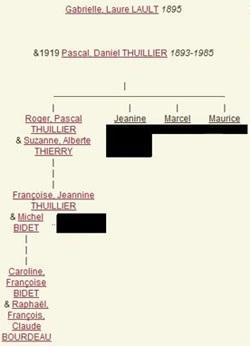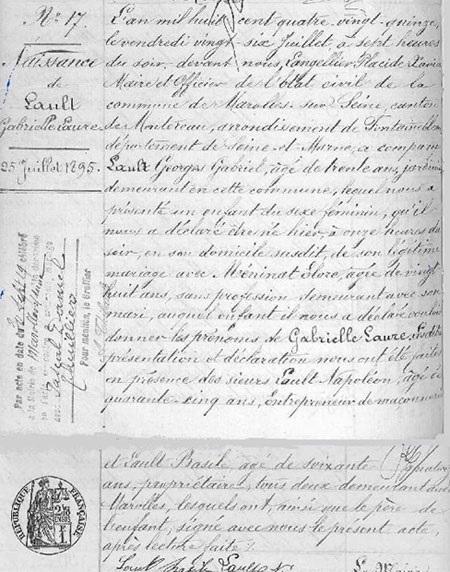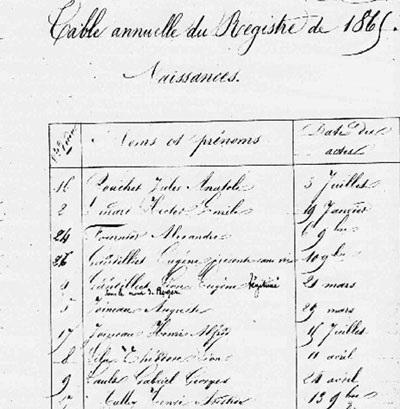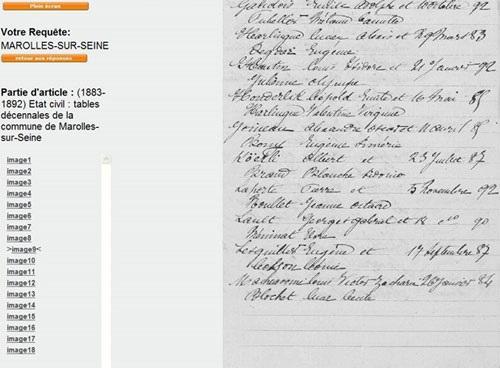Flash info

Fermeture de la salle de lecture
Fermeture annuelle de l'accueil du public du 24 décembre 2025 à 17h00 au lundi 5 janvier 2026 à 9h00.
Outil
For a birth, marriage or death, you must know the date and place of the deed to view the corresponding civil register record. Search techniques can be used to find deeds for which the exact date or place is unknown.

A genealogical search can start with family memoirs, using family books, annotated and dated photographs and records of births, deaths and marriages. Family records were used to establish the beginning of the above family tree, with the following information :
The use of archives was then necessary.
Civil register documents (birth and marriage records) only become accessible to the public after 75 years. Some more recent documents can be obtained (e.g. by family members) from the civil registry services.
Birth, death and marriage records are kept in the department where the events took place and are ranked by municipality. It is therefore essential to know the department in which to make the search, and it is preferable to know the municipality also. In the specific case of ancestors living in hamlets or gaps, the parish or municipality in question can be identified using the reference work by M. Le Mee-Orsetti and R. Mee, Paroisses et communes de France, Paris, 1988 (available in the reading room, shelf mark 8o3919/A).
If the municipality is not known, a systematic consultation of the tables décennales (ten-year civil register tables) will be required.
All these deeds are as distributed as follows :

If the date of the deed and the parish or municipality where it took place are known, it is "sufficient" to consult the appropriate register, where the deeds have been entered chronologically.
If the exact year of the deed is not known, but the period is known, then the tables can be used.
To continue with the above example of a genealogical search, Gabrielle Lault is relatively easy to locate. She was born in 1895 in Marolles-sur-Seine. By querying the ten-year table of this municipality for the period 1893-1902 (shelf mark 7E261), the exact date of her birth was found.
To speed up consultation of the register itself, estimation of the location of the deed can be very useful. The birth of Gabrielle Lault was on 25 July, 1895, and is recorded in the Marolles-sur-Seine civil register at shelf mark 6E297 / 9, which is in the period 1888 to 1905. We can therefore assume that the deed will appear at the end of the first half of the register. The numerical query produces 371 views, and the deed in question is under the 158th.
Viewing the deed itself provides access to a range of information :
Gabrielle Lault's birth certificate provides the following information about her parents :
To continue searching for information on these people, in the absence of a known date for acts involving them, a search could be made for their birth certificates, marriage certificate or their death certificates.
Consulting the ten-year tables from 1863 to 1872 does not enable the desired birth certificates to be identified. There is another possibility: search the civil registers for the whole of the presumed year as an oversight in the ten-year table is possible. The annual registry table will be the first thing to consult.
Searching civil registers enabled Gabriel Lault to be found. He was born in the municipality of Marolles-sur-Seine in 1865, as shown in the annual registry table. It is not known why he is not mentioned in the ten-year table.
There is no trace of Elore, however, either in the table or in the corresponding register. It may be that she was not born in this municipality. External documents will be necessary to continue the search elsewhere.
In the case of Gabriel Lault and Elore Meninat, consultation of the 1883-1892 ten-year table (7E234) proves successful: the marriage took place on 18 November, 1890.
Consultation of the deed itself (listed at registry shelf mark 6E297 / 9, for the period 1888 to 1905) enables the information to completed.
It explains the failure of the birth certificate search for Elore, who was born in a municipality in Loir-et-Cher, where the search can be resumed.
The search for Gabriel Lault, born in Seine-et-Marne, can continue in the same way: search for the marriage certificate, the birth and death certificates of his parents. It is also possible to consult the ten-year tables to try to find the birth of any siblings of Gabrielle.



Civil register analyses
Some civil registers have been analysed by Seine-et-Marne genealogy circles. Any gaps in searches can be verified by consulting the tables available in the reading room.
Dispensations from the bishop (Series G)
They help reconstruct a marriage certificate, if no mention of it has been found in the parish archives, or when the originals have been destroyed or lost.
Electoral rolls (sub-series 6M)
Consultation of electoral rolls can supplement information about an ancestor. It is also very helpful if the birthplace is unknown but the place of residence at a specified date is known. The search, which for a long time may involve only male ancestors, must take account of changes in voter status and eligibility conditions during the 18th and 19th centuries :
1789 : Every adult citizen is eligible; electoral rolls show the name, occupation, department of residence, arrondissement where taxes are paid.
1817 : Requirements: must be aged at least 30 and paying at least 300 francs in tax to be an elector. The information is identical to that of the rolls of 1789.
1848 : Direct universal suffrage was introduced in the constitution. Voting age: 25. Same information in the rolls.
1852 : Tables of voters now gave the date and place of birth of the person concerned.
1944 : The right to vote was granted to women.
1974 : Age of majority was lowered to 18.
Electoral records contain the swearing in and biographies of candidates and may be a valuable source about such people.
Population censuses (sub-series 10M)
Population censuses have existed since 1836 and are made public after a period of 50 years (so as not to jeopardize individual privacy).
These are lists of names that indicate the composition of the family by household: name, surname, profession or status of each member.
Censuses are brought together under the same shelf-mark for the same year and canton by canton. It is therefore necessary to know which canton the municipality is connected to and the year to be consulted, in order to request the relevant document.
Notarial archives (series E)
They include marriage contracts and inheritances (wills, probate inventories), transfers of ownership.
In the absence of an exact date, the search will start from the notarial directories of the place of residence to find traces of the desired surname.
The following can be consulted in the reading room: dictionary of notaries and notarial offices of Seine-et-Marne, developed by the Departmental Archives of Seine-et-Marne.
Other documents
Other series held in the departmental archives may also contain additional information, both on genealogy itself and on the life situation, occupation, assets etc.
In the old series, a file can provide a reference to a family name, a title, a parish or a trade.
References to a royal office (series A) or family title (series E) may also be found. For example :
Searches of the tax records, based on place of residence, provide insight to the economic and social categories of the individuals involved.
A search on the profession can also be conducted systematically.
Highly unusual family situations may also be documented by the use of other series :